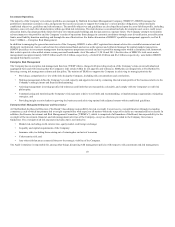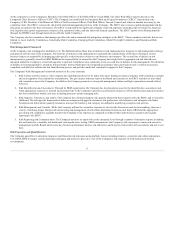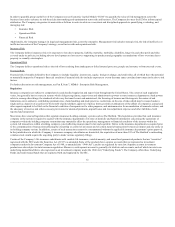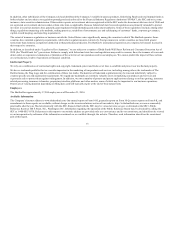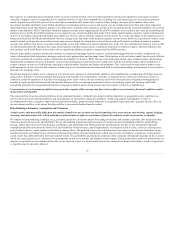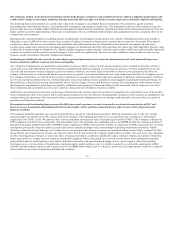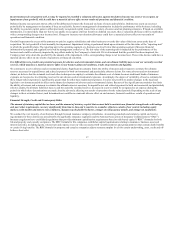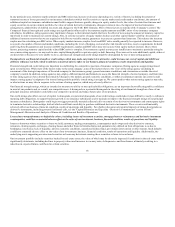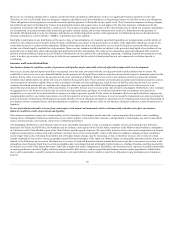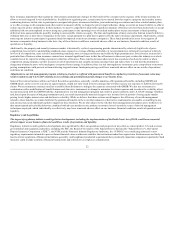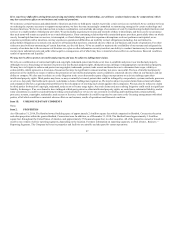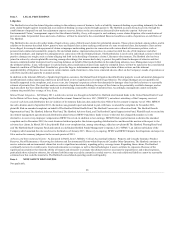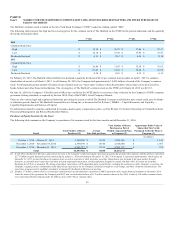The Hartford 2014 Annual Report Download - page 20
Download and view the complete annual report
Please find page 20 of the 2014 The Hartford annual report below. You can navigate through the pages in the report by either clicking on the pages listed below, or by using the keyword search tool below to find specific information within the annual report.
Moreover, as a holding company that is separate and distinct from our insurance subsidiaries, we have no significant business operations of our own.
Therefore, we rely on dividends from our insurance company subsidiaries and other subsidiaries as the principal source of cash flow to meet our obligations.
These obligations include payments on our debt securities and the payment of dividends on our capital stock. The Connecticut insurance holding company
laws limit the payment of dividends by Connecticut-domiciled insurers and require notice to and approval by the state insurance commissioner for the
declaration or payment of dividends above certain levels. The insurance holding company laws of the other jurisdictions in which our insurance subsidiaries
are incorporated, or deemed commercially domiciled, generally contain similar, and in some instances more restrictive, limitations on the payment of
dividends. Dividends paid to us by our insurance subsidiaries are further dependent on their cash requirements. For further discussion on dividends from
insurance subsidiaries, see Part II, Item 7, MD&A - Capital Resources & Liquidity.
Our rights to participate in any distribution of the assets of any of our subsidiaries, for example, upon their liquidation or reorganization, and the ability of
holders of our common stock to benefit indirectly from a distribution, are subject to the prior claims of creditors of the applicable subsidiary, except to the
extent that we may be a creditor of that subsidiary. Holders of our capital stock are only entitled to receive such dividends as our board of directors may
declare out of funds legally available for such payments. Moreover, our common stockholders are subject to the prior dividend rights of any holders of our
preferred stock or depositary shares representing such preferred stock then outstanding. The terms of our outstanding junior subordinated debt securities
prohibit us from declaring or paying any dividends or distributions on our capital stock or purchasing, acquiring, or making a liquidation payment on such
stock, if we have given notice of our election to defer interest payments but the related deferral period has not yet commenced or a deferral period is
continuing.
Our business, financial condition, results of operations and liquidity may be materially adversely affected by unfavorable loss development.
Our success, in part, depends upon our ability to accurately assess the risks associated with the coverage provided to policyholders that we insure. We
establish loss reserves to cover our estimated liability for the payment of all unpaid losses and loss expenses incurred with respect to premiums earned on the
policies that we write. Loss reserves do not represent an exact calculation of liability. Rather, loss reserves are estimates of what we expect the ultimate
settlement and administration of claims will cost, less what has been paid to date. These estimates are based upon actuarial and statistical projections and on
our assessment of currently available data, as well as estimates of claims severity and frequency, legal theories of liability and other factors. Loss reserve
estimates are refined periodically as experience develops and claims are reported and settled. Establishing an appropriate level of loss reserves is an
inherently uncertain process. Because of this uncertainty, it is possible that our reserves at any given time will prove inadequate. Furthermore, since estimates
of aggregate loss costs for prior accident years are used in pricing our insurance products, we could later determine that our products were not priced
adequately to cover actual losses and related loss expenses in order to generate a profit. To the extent we determine that losses and related loss expenses are
emerging unfavorably to our initial expectations, we will be required to increase reserves. Increases in reserves would be recognized as an expense during the
period or periods in which these determinations are made, thereby adversely affecting our results of operations for the related period or periods. Depending on
any changes in these estimated losses, such determinations could have a material adverse effect on our business, financial condition, results of operations or
liquidity.
We are particularly vulnerable to losses from catastrophes, both natural and man-made, which could materially and adversely affect our business,
financial condition, results of operations and liquidity.
Our insurance operations expose us to claims arising out of catastrophes. Catastrophes can be caused by various unpredictable natural events, including,
among others, earthquakes, hurricanes, hailstorms, severe winter weather, wind storms, fires, tornadoes, and pandemics. Catastrophes can also be man-made,
such as terrorist attacks, cyber-attacks, explosions or infrastructure failures.
The geographic distribution of our business subjects us to catastrophe exposure for events occurring in a number of areas, including, but not limited to,
hurricanes in Florida, the Gulf Coast, the Northeast and the Atlantic coast regions of the United States, tornadoes in the Midwest and Southeast, earthquakes
in California and the New Madrid region of the United States, and the spread of disease. We expect that increases in the values and concentrations of insured
employees and property in these areas will continue to increase the severity of catastrophic events in the future. In addition, changing climate conditions
across longer time scales, including the potential risk of broader climate change, may be increasing, or may in the future increase, the severity of certain
natural catastrophe losses across various geographic regions.Potential examples of the impact of climate change on catastrophe exposure include, but are not
limited to the following: an increase in the frequency or severity of wind and thunderstorm and tornado/hailstorm events due to increased convection in the
atmosphere, more frequent brush fires in certain geographies due to prolonged periods of drought, higher incidence of deluge flooding, and the potential for
an increase in severity of the largest hurricane events due to higher sea surface temperatures. In addition, our businesses have exposure to global or nationally
occurring pandemics caused by highly infectious and potentially fatal diseases, and are spread through human, animal or plant populations. Additionally,
due to such catastrophes, caused by natural or man-made events, policyholders may be unable to meet their obligations to pay premiums on our insurance
policies.
20


